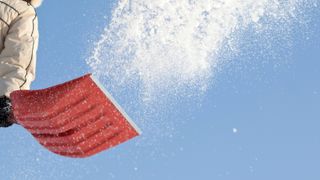Shoveling snow is actually really good exercise, if you have the right technique
Turn shoveling snow into an effective workout that can burn calories and build strength


While it might look pretty from your bedroom window, snow and ice can cost time and energy to clear. The good news is, there are physical benefits to shoveling snow, as long as we do it correctly. According to experts, it not only helps build upper body strength, but also burns calories, causes your heart to beat faster, and works your abdominal muscles.
How much snow we get every year is dependent on where we are in the world. In the UK, the most snow or sleet falls in Scotland, 38.1 days on average, according to the Met Office. In the US, Washington comes out on top, with 645.5 inches being the average annual snowfall in this state. We asked the experts about the health benefits of this household chore and what to bear in mind before, and during, clearing snow, as well as how to shovel snow safely.
Is shoveling snow good exercise?
When done properly, much like walking for weight loss, snow shoveling can be an effective workout. Not only does it work your arms, but also your glutes and your core—it's a secret ab workout! With the help of the experts, we discover the key areas snow shoveling targets and the benefits for your health.
Full-body workout
"Shoveling snow can be a great form of exercise with many benefits," says PT Bianca Nicklen, explaining how shoveling snow can be a great at-home workout for strength training. "It uses the whole body, including large muscle groups such as the legs, back, and core muscles." When you think of the motion of shoveling, it's clear that there are many different components involved, including the glutes, quads, hamstrings, and core, which is what makes it such a great exercise for working every part of your body.
"The rotation from the trunk of the body involved in shoveling means it uses the obliques and transverse abdominals,", says Nicklen. "Which is often neglected in many standard exercise routines. If you want to up the ante, then make sure to tense your midsection as you move to keep your core engaged and fired up."
When shoveling snow, it's good to be aware of the impact that the rotation can have on your back and hips. One of the benefits of swimming and walking is that they are low impact, but hauling around snow can put pressure on your joints, so warm up first with a stretching session (try our guides to yoga for beginners or pilates for beginners) or a gentle jog, keep your knees bent as you shovel and hinge from your hips rather than your lower back.
Upper-body booster

Upper-body strength is important for a number of different reasons, including added mobility as you age, flexibility, and posture. "Shoveling snow will literally use nearly every muscle in the body from the legs, core, shoulders, and arms," says fitness expert Damien Coates.
Sign up for the woman&home newsletter
Sign up to our free daily email for the latest royal and entertainment news, interesting opinion, expert advice on styling and beauty trends, and no-nonsense guides to the health and wellness questions you want answered.
"While it's wonderful to have toned and sculpted arms strengthening your upper body will also help with the following," says PT Caroline Idiens.
- Posture—training our muscles with correct technique (especially the back) will ensure we have a better posture, from how we sit at our desks, behind the wheel of the car, to walking, cycling, and in everyday activities. By strengthening our backs and our core, we will have better alignment and be more conscious of not hunching our shoulders forward or slouching as we move.
- Everyday activities—strength in our upper body will help hugely with daily activities such as housework, gardening, general lifting and leave us less prone to injuries—who knew snow shoveling could be a boost to our favorite hobbies for women?
- Improve our overall fitness—with a strong upper body you will get more out of other exercises in your fitness program. For example, a strong core and a strong back will help hugely in your lower body exercises such as squats, with the correct technique, planks, mountain climbers, and other glute exercises. With a strong upper body, you will have more balance and also be better coordinated.
- Essential for sports— a strong upper body is key for so many well-loved sports, including tennis, golf, swimming, and cycling, to name a few. Strong shoulders, arm strength, and core strength will all help you to maximize your performance on the pitch or in the pool.
- Metabolism boost— let's not forget that the more muscle you have, the higher your resting metabolic rate (if you want more information on working your metabolic age, take a look at our guide). Plus, with strength training, you continue to burn calories long after the workouts have ended. Meaning that upper body workouts are an excellent way to manage your weight.
Aerobic exercise
There are also cardio benefits to clearing away snow. “The repetitive nature of shoveling makes it a great functional aerobic exercise,” explains Nicklen. “As it works the whole body in a very efficient way.” In fact, snow shoveling could easily be classed as a hard workout, as it causes your heart to beat faster.
“The actions and movement of shoveling snow can be quite vigorous and tough,” says fitness expert Damien Coates. “It uses quite a lot of muscles and burns quite a lot of calories while getting your heart rate pumping at the same time."
How many calories can you burn shoveling snow?
Want to know how many calories you can burn from shoveling snow? According to a study from Harvard Health Publishing, a 155-pound person shoveling snow for 30 minutes burns about 223 calories. If you really want to make your next snow shoveling session a workout, then why not throw in some squats or lunges as you shovel. Not only will this torch calories, but it will also stop you from stiffening up from the repetitive movement that comes with moving and shoveling heavy snow.
How to shovel snow safely
Of course, as with any heart-pumping workout, there are risks involved. That, combined with the fact it takes our bodies longer to warm up when it’s chilly outside, means that colder weather puts us at greater risk for coronary heart disease and stroke hospitalizations, according to research carried out by the BMJ journal Heart.
However, that doesn’t mean everyone who shovels snow is at increased risk of hospitalization. Studies show that it only tends to be people with pre-existing cardiac issues, such as high blood pressure, who are more at risk of needing medical attention. If you do fall into this category, then it's best to have a conversation with a healthcare professional prior to you picking up a shovel, or better yet, if you know there is snow forecasted to fall in your area, then consult your doctor beforehand. If you can't do any of these things, then wearing a heart rate monitor can be a great way of keeping an eye on your exertion.
Warming up beforehand, taking breaks, and holding the shovel correctly (using a wide grip on the handle and placing your other hand nearer the shovel itself) are all key to making sure that you don't overexert yourself, or pull something. And of course, don't forget to wrap up warm in a winter coat if you're outside for an extended period of time.
w&h thanks PT Bianca Nicklen, Senior Performance Coach for Club 51 Intelligent Fitness, Damien Coates, fitness expert and founder and owner of, The Lean Body Project, and Caroline Idiens, PT and founder of Caroline's Circuits.
With five years of experience working across print and digital publications, Stacey is a journalist who specializes in writing about the latest developments in health and wellbeing. She has also previously written for Women’s Health, Get The Gloss, Fit & Well, Stylist, and Natural Health magazine, covering current health trends and interviewing leading figures in the wellness space.
When she’s not talking to health experts, you can probably find her hiking somewhere in the Welsh countryside or near the coast. Her favorite two ways to switch off are a Pilates class and a glass of wine with a home-cooked meal.
-
 32 facts about Queen Elizabeth II's Coronation that you may never heard of before
32 facts about Queen Elizabeth II's Coronation that you may never heard of beforeQueen Elizabeth II's Coronation was a monumental moment in history and the first event many watched on TV
By Lauren Hughes Published
-
 Meghan Markle's squeaky snack is a mouth-watering classic and she knows straightaway if she's 'got the right kind'
Meghan Markle's squeaky snack is a mouth-watering classic and she knows straightaway if she's 'got the right kind'Meghan Markle's squeaky snack is deliciously decadent and it seems she's a purist when it comes to one of the key ingredients
By Emma Shacklock Published